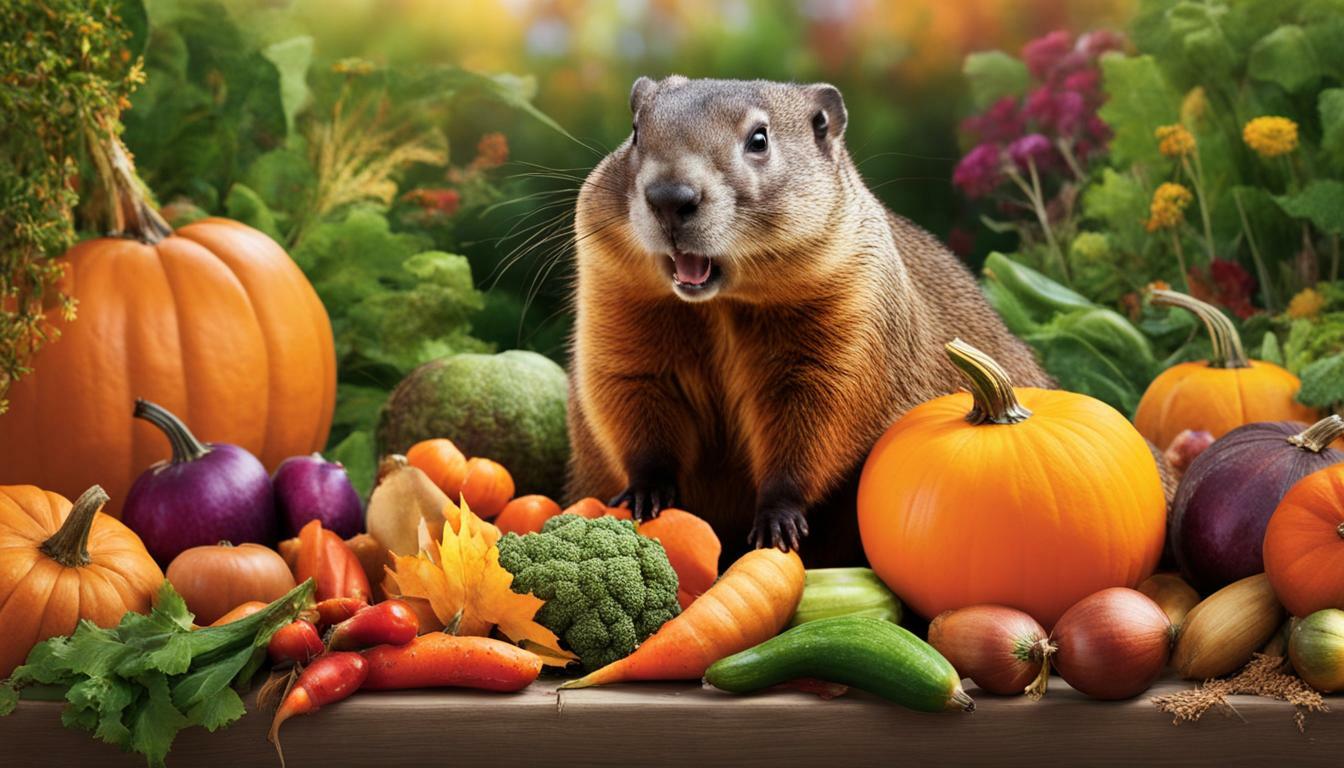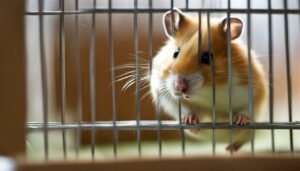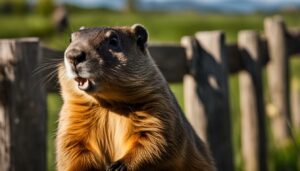Groundhogs, also known as woodchucks, are herbivorous animals that consume a variety of plant-based foods. But the question remains: do they eat pumpkins? Let’s explore the groundhog diet, their food preferences, and whether pumpkins are on the menu for these furry creatures.
Key Takeaways:
- Groundhogs are herbivorous animals that eat a variety of plant-based foods.
- Pumpkins are part of a groundhog’s diet and provide them with essential nutrients.
- To protect pumpkins from groundhogs, you can use methods like installing fences, using repellents, and blocking their burrows.
- Other animals, such as rabbits, squirrels, deer, possums, and hedgehogs, may also have a taste for pumpkins.
- It’s important to take appropriate measures to safeguard pumpkins from these animals.
Understanding Groundhog Diet
Groundhogs have a primarily vegetarian diet, consisting of various plants, grasses, and crops. They are herbivorous animals with a preference for leafy green vegetables and fruits. Their diet is essential for their survival and overall health, providing them with the necessary nutrients and energy.
When it comes to plants, groundhogs consume a variety of vegetation such as clover, dandelion, plantain, and grass. These leafy greens are rich in vitamins and minerals that contribute to their well-being. Groundhogs also indulge in fruits, including berries, apples, and the subject of our inquiry – pumpkins.
Pumpkins are a favorite food choice for groundhogs due to their appealing taste and nutritional value. They have a high water content, which helps keep groundhogs hydrated during hot summer months. Groundhogs may also consume pumpkin leaves, stems, flowers, and seeds, making use of every part of this versatile plant. Pumpkin seeds, in particular, are a great source of protein, healthy fats, and essential minerals for these furry fellows.
| Groundhog Diet | Examples |
|---|---|
| Leafy Greens | Clover, dandelion, plantain, grass |
| Fruits | Berries, apples, pumpkins |
| Other Plants | Tubers, bark, tree sap |
It’s important to note that groundhogs are opportunistic feeders and may consume other plants, tubers, bark, and even tree sap when available. However, their preference lies in fresh foliage and fruits.
Understanding groundhog eating habits and nutrition is essential for protecting your pumpkins and maintaining a harmonious coexistence with these fascinating creatures. By implementing effective preventive measures, such as installing fences, using repellents, blocking burrows, and employing agricultural lime, you can enjoy your pumpkins without worrying about them disappearing overnight.
Exploring Pumpkin Consumption by Groundhogs
While groundhogs may not be commonly associated with pumpkin consumption, these animals do indeed eat pumpkins. As herbivorous creatures, groundhogs have a varied diet that includes fruits, vegetables, and plants. Pumpkins, with their vibrant colors and robust flavors, can be an enticing food choice for these furry creatures.
Groundhogs have been known to consume various parts of a pumpkin, including the leaves, stems, fruits, flowers, and seeds. They are particularly fond of the tender leaves and stems, which provide them with essential nutrients. In addition, groundhogs can also feast on the ripe fruits of the pumpkin, relishing the rich flavors and natural sweetness.
To protect your pumpkins from groundhog consumption, several methods can be employed. Installing fences around your garden can help create a physical barrier that deters groundhogs from accessing your pumpkins. Using repellents can also be effective in deterring these animals, as they dislike the strong scents associated with such products. Motion-activated systems that emit sounds or vibrations can further discourage groundhogs from approaching your pumpkins.
| Groundhog Pumpkin Consumption | Recommended Protection Methods |
|---|---|
| Leaves and Stems | Install fences, use repellents |
| Fruits | Install fences, use repellents, motion-activated systems |
| Flowers and Seeds | Install fences, use repellents |
It is worth noting that groundhogs are not the only animals that may have a taste for pumpkins. Rabbits, squirrels, deer, possums, and hedgehogs are also known to indulge in these autumn delights. Therefore, it is essential to take appropriate measures to protect your pumpkins from these creatures as well.
By implementing strategies such as installing fences, using repellents, blocking groundhog burrows, and utilizing agricultural lime as a deterrent, you can help safeguard your pumpkins from these hungry visitors. With these precautions in place, you can enjoy the sight of flourishing pumpkins without worrying about them becoming a tempting feast for groundhogs and other animals.
Groundhogs and Pumpkins: What They Consume
Groundhogs have been observed consuming different parts of a pumpkin plant, including the leaves, stems, fruits, flowers, and seeds. As herbivorous animals, groundhogs rely on a variety of plant-based foods to meet their nutritional needs, and pumpkins happen to be one of their preferred choices. These plump orange fruits provide groundhogs with essential nutrients and are a source of hydration in their diet.
When it comes to pumpkins, groundhogs are known to eat both the flesh and the seeds. They are particularly drawn to the tender leaves and stems, which they find palatable and easily accessible. Additionally, groundhogs have been observed nibbling on the vibrant flowers of the pumpkin plant. These blossoms not only provide a tasty treat but also contribute to the groundhog’s dietary diversity.
To further illustrate the extent of groundhog’s affinity for pumpkins, here is a breakdown of the different parts of the pumpkin that they consume:
| Part of the Pumpkin | Consumed by Groundhogs |
|---|---|
| Leaves | Yes |
| Stems | Yes |
| Fruits | Yes |
| Flowers | Yes |
| Seeds | Yes |
Knowing the food preferences of groundhogs can be valuable information for those looking to protect their pumpkins from these curious critters. By understanding what groundhogs consume, you can implement effective strategies, such as installing fences, using repellents, or even employing motion-activated systems to deter them from indulging in your pumpkin patch. Taking appropriate measures is essential to ensure your pumpkins remain intact and ready for harvest!
Protecting Pumpkins from Groundhogs
If you want to protect your pumpkins from groundhogs, there are several effective methods you can employ. Groundhogs, with their voracious appetites, can quickly devour your prized pumpkins, leaving you with nothing but a stem and a few sad memories. But fear not! With a little ingenuity and some preventive measures, you can keep these furry garden bandits at bay.
One of the most common ways to deter groundhogs from snacking on your pumpkins is by installing fences. A sturdy fence around your pumpkin patch will create a physical barrier that can help keep these hungry critters out. Be sure to bury the fence at least one foot deep to prevent them from burrowing underneath. Additionally, you can make the fence even more effective by adding wire mesh or chicken wire along the bottom portion, as groundhogs are skilled climbers.
Another option is to use repellents specifically designed to deter groundhogs. These repellents usually contain natural ingredients that emit strong scents or tastes that groundhogs find unpleasant. Spraying or applying these repellents around your pumpkins can help deter groundhogs from approaching them. Remember to reapply the repellent after rainfall or watering to maintain its effectiveness.
If you prefer a more high-tech approach, you can invest in motion-activated systems. These devices use sensors to detect the presence of groundhogs or other wildlife and emit a noise, spray, or burst of water, startling them and encouraging them to retreat. This can be an effective way to keep groundhogs away from your pumpkin patch without constant monitoring or maintenance.
| Methods to Protect Pumpkins from Groundhogs |
|---|
| Install fences around your pumpkin patch, burying them at least one foot deep. |
| Add wire mesh or chicken wire along the bottom portion of the fence to prevent burrowing. |
| Use repellents specifically designed to deter groundhogs. |
| Consider motion-activated systems that startle groundhogs and encourage them to retreat. |
Other Animals That May Eat Pumpkins
Groundhogs are not the only animals that may enjoy feasting on pumpkins; several other creatures also find them enticing. Let’s take a look at some of these pumpkin-loving animals:
Rabbits
Rabbits have a fondness for pumpkins and are known to consume both the flesh and the seeds. They are attracted to the sweetness of the fruit and can quickly devour a pumpkin if given the chance.
Squirrels
Squirrels are notorious for their love of pumpkins, especially during the fall season when they are abundant. They are adept at climbing trees and will not hesitate to gnaw through a pumpkin to get to the seeds inside.
Deer
Deer are herbivorous animals and pumpkins provide a tasty treat for them, especially in areas where other food sources may be scarce. They are known to graze on pumpkin plants and can cause significant damage to pumpkin patches.
Possums
Possums have a varied diet and are not averse to indulging in a pumpkin feast. They are opportunistic eaters and will gladly feast on pumpkins if given the chance. However, their consumption is generally limited to the softer parts of the fruit.
Hedgehogs
Hedgehogs are nocturnal creatures that have a diverse diet. While pumpkins may not be their primary food choice, they have been known to nibble on them if they come across a pumpkin patch.
Given the popularity of pumpkins among these animals, it is important to take measures to protect them if you want to enjoy a bountiful harvest. Consider using fences, repellents, motion-activated systems, and other protective measures to safeguard your pumpkins from being devoured by these pumpkin-loving creatures.
Protecting Pumpkins from Other Animals
To protect your pumpkins from a range of animals, including rabbits, squirrels, deer, possums, and hedgehogs, you can employ various strategies. By implementing these measures, you can ensure that your prized pumpkins remain intact and undisturbed.
Fences
One effective method is to install fences around your pumpkin patch. Use chicken wire or mesh fencing that is at least three feet tall, burying it a few inches below the ground to prevent burrowing animals from digging under it. Make sure the fence is sturdy and tightly secured to deter larger animals like deer from jumping over.
Repellents
Another option is to use repellents that are designed to deter animals from approaching your pumpkins. You can find commercially available repellents specifically formulated to repel rabbits, squirrels, deer, possums, and hedgehogs. Apply these repellents according to the manufacturer’s instructions and reapply after rain or heavy watering.
Motion-Activated Systems
If you’re dealing with persistent animal visitors, consider installing motion-activated systems. These devices use sensors to detect movement and emit a loud noise or a burst of water to scare away intruders. Place them strategically around your pumpkin patch to effectively deter animals from approaching.
| Animal | Strategy |
|---|---|
| Rabbits | Use fences or repellents specifically formulated for rabbits. Planting marigolds and mint around your pumpkin patch can also help keep them away. |
| Squirrels | Use fences or repellents specifically formulated for squirrels. You can also try placing squirrel-proof netting over your pumpkins. |
| Deer | Use tall and sturdy fences, ideally with a height of at least eight feet. Planting deer-resistant plants around your pumpkin patch can also help deter them. |
| Possums | Use fences or repellents specifically formulated for possums. Remove any potential food sources or shelter near your pumpkin patch. |
| Hedgehogs | Use fences or repellents specifically formulated for hedgehogs. Remove any tempting hiding spots or debris around your pumpkin patch. |
Remember, no single method may be completely foolproof, as animals can be inventive when it comes to accessing food. By combining multiple strategies and remaining vigilant, you can significantly reduce the risk of pumpkin damage and enjoy the fruits of your labor.
The Science Behind Groundhog Diet Choices
There are scientific explanations for why groundhogs may choose certain foods over others and prefer specific plant species. These herbivorous animals have specific nutritional needs, and their diet plays a crucial role in their overall health and survival.
One factor that influences groundhog food preferences is the availability of certain plants in their habitat. Groundhogs are opportunistic feeders, meaning they will consume whatever vegetation is abundant and easily accessible. This is why they are often found in areas with lush vegetation, such as fields, meadows, and gardens.
Research has also shown that groundhogs have specialized taste receptors that allow them to differentiate between various plant species. They may find certain plants more palatable and nutritionally beneficial than others, leading them to develop preferences for specific vegetation. For example, groundhogs are known to enjoy the taste and texture of pumpkin leaves, stems, fruits, flowers, and seeds.
| Parts of Pumpkin | Consumed by Groundhogs |
|---|---|
| Leaves | Yes |
| Stems | Yes |
| Fruits | Yes |
| Flowers | Yes |
| Seeds | Yes |
To protect your pumpkins from groundhogs and other animals, it is important to take appropriate measures. Installing fences around your garden can create a physical barrier that prevents groundhogs from accessing the pumpkins. Using repellents and motion-activated systems can also deter groundhogs from approaching the pumpkins in the first place. Blocking groundhog burrows can limit their access to your garden, while the use of agricultural lime can act as a deterrent due to its strong odor.
It’s worth noting that groundhogs are not the only animals that may have a taste for pumpkins. Animals like rabbits, squirrels, deer, possums, and hedgehogs may also be attracted to the delicious scent and taste of pumpkins. Therefore, it’s essential to protect your pumpkins from these potential pumpkin lovers as well.
Blocking Groundhog Burrows
Blocking groundhog burrows is an essential step in preventing them from accessing your pumpkins and causing damage to your garden. These burrows serve as the groundhog’s home, as well as their access point to your precious crops. By blocking their burrows, you effectively create a barrier that limits their ability to reach the pumpkins and other vegetation in your garden.
There are a few methods you can employ to block groundhog burrows. One option is to use wire mesh or hardware cloth to cover the entrance of the burrow. This prevents the groundhogs from entering or exiting the burrow, discouraging them from making your garden their territory.
Another method is to fill the burrow with soil or rocks. This not only blocks their access but also collapses the burrow, making it less appealing for the groundhogs to reclaim. However, it’s important to note that groundhogs are persistent creatures, so regularly monitoring and maintaining these blockades is crucial to ensure their effectiveness.
| Methods | Advantages | Disadvantages |
|---|---|---|
| Wire mesh or hardware cloth | Prevents groundhog access while allowing airflow | Requires regular monitoring and maintenance |
| Soil or rocks | Blocks access and collapses burrows | May need frequent reapplication |
Summary:
- Blocking groundhog burrows is crucial to protect your pumpkins and garden from their damage.
- Methods include using wire mesh or hardware cloth to cover burrow entrances and filling burrows with soil or rocks.
- Regular monitoring and maintenance are necessary for these methods to remain effective.
Using Agricultural Lime to Deter Groundhogs
Agricultural lime can be an effective tool in deterring groundhogs from targeting your pumpkins by making them less appealing to these animals. Groundhogs are herbivorous creatures that enjoy feasting on various parts of the pumpkin plant, including the leaves, stems, fruits, flowers, and seeds. However, the application of agricultural lime can help discourage these pesky critters from indulging in your pumpkin patch.
So how exactly does agricultural lime work? Well, it alters the pH level of the soil, making it less favorable for groundhogs. These animals prefer a more neutral pH, and the addition of lime makes the soil more alkaline. This change in pH disrupts their feeding habits and can deter them from venturing near your pumpkins.
To use agricultural lime as a deterrent, begin by testing the soil’s pH level. You can purchase a pH testing kit from your local gardening store. Once you have determined that the soil is more acidic than desired, sprinkle the agricultural lime evenly over the affected area. Be sure to follow the manufacturer’s instructions for the correct application rate. After spreading the lime, water the soil thoroughly to help it absorb the lime and adjust the pH level.
While agricultural lime is a valuable tool to discourage groundhogs, it’s important to keep in mind that it is not foolproof. Groundhogs are persistent creatures and may still be drawn to your pumpkins, especially if other food sources are scarce. Therefore, it is recommended to combine the use of agricultural lime with other groundhog deterrents, such as fencing, repellents, and motion-activated systems, to ensure maximum protection for your pumpkins.
| Deterrent Method | Effectiveness |
|---|---|
| Agricultural Lime | Partially Effective |
| Fencing | Highly Effective |
| Repellents | Moderately Effective |
| Motion-Activated Systems | Highly Effective |
Conclusion
Groundhogs, being herbivores, include pumpkins in their diet, consuming various parts of the plant and making them a potential target for protection measures. These furry creatures find pumpkins appealing and nutritious, feasting on their leaves, stems, fruits, flowers, and seeds. However, if you want to safeguard your pumpkins from these hungry garden visitors, there are several methods you can employ.
Installing fences is an effective way to keep groundhogs at bay. Make sure the fence is buried at least a foot deep to prevent them from burrowing underneath. Additionally, using repellents, such as those containing garlic or predator urine, can discourage groundhogs from approaching your pumpkins.
Motion-activated systems can also be utilized, emitting sounds or spraying water when triggered by the presence of groundhogs. This startles them and discourages them from returning to your precious pumpkins. Another measure to consider is blocking their burrows. By sealing off their underground homes, you limit their access to your garden.
For an extra layer of protection, agricultural lime can be spread around your pumpkins. Groundhogs find the taste of lime unpleasant, deterring them from taking a nibble. Remember, though, to reapply the lime after rain to ensure its effectiveness.
It’s important to note that groundhogs aren’t the only animals that may have a taste for pumpkins. Rabbits, squirrels, deer, possums, and hedgehogs are also known to indulge in these orange delicacies. To safeguard your pumpkins from these critters, it’s advisable to implement similar protective measures, including fencing and repellents.
By taking appropriate steps to protect your pumpkins, you can ensure they remain intact and ready for carving come Halloween. So, don’t let these furry foragers have all the fun – shield your pumpkins from their appetites and enjoy the fruits of your gardening labor.
FAQ
Do groundhogs eat pumpkins?
Yes, groundhogs do eat pumpkins. They consume the leaves, stems, fruits, flowers, and seeds of pumpkins as part of their herbivorous diet. Pumpkins provide them with essential nutrients.
How can I prevent groundhogs from eating my pumpkins?
There are several methods you can use to protect your pumpkins from groundhogs. Installing fences, using repellents, utilizing motion-activated systems, blocking groundhog burrows, and using agricultural lime are effective ways to deter them.
What other animals may eat pumpkins?
Besides groundhogs, other animals that may consume pumpkins include rabbits, squirrels, deer, possums, and hedgehogs. It is important to take appropriate measures to protect pumpkins from these animals as well.




